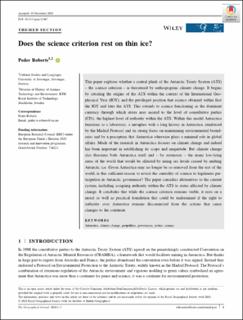| dc.contributor.author | Roberts, Peder William Chellew | |
| dc.coverage.spatial | Antarctica | en_US |
| dc.date.accessioned | 2021-02-19T14:40:01Z | |
| dc.date.available | 2021-02-19T14:40:01Z | |
| dc.date.created | 2020-12-19T21:01:11Z | |
| dc.date.issued | 2020-11 | |
| dc.identifier.citation | Roberts, P.W.C. (2020) Does the science criterion rest on thin ice? Geographical Journal, https://doi.org/10.1111/geoj.12367 | en_US |
| dc.identifier.issn | 0016-7398 | |
| dc.identifier.uri | https://hdl.handle.net/11250/2729312 | |
| dc.description.abstract | This paper explores whether a central plank of the Antarctic Treaty System (ATS) – the science criterion – is threatened by anthropogenic climate change. It begins by situating the origins of the ATS within the context of the International Geophysical Year (IGY), and the privileged position that science obtained within first the IGY and later the ATS. This extends to science functioning as the dominant currency through which states may ascend to the level of consultative parties (CPs), the highest level of authority within the ATS. Within this model Antarctica functions as a laboratory, a metaphor with a long history in Antarctica, reinforced by the Madrid Protocol and its strong focus on maintaining environmental boundaries and by a perception that Antarctica otherwise plays a minimal role in global affairs. Much of the research in Antarctica focuses on climate change and indeed has been important in establishing its scope and magnitude. But climate change also threatens both Antarctica itself and – by extension – the many low‐lying areas of the world that would be affected by rising sea levels caused by melting Antarctic ice. Given Antarctica may no longer be so removed from the rest of the world, is this sufficient reason to revisit the centrality of science to legitimate participation in Antarctic governance? The paper considers alternatives to the current system, including assigning authority within the ATS to states affected by climate change. It concludes that while the science criterion remains viable, it rests on a moral as well as practical foundation that could be undermined if the right to authority over Antarctica remains disconnected from the actions that cause changes to the continent. | en_US |
| dc.language.iso | eng | en_US |
| dc.publisher | The Royal Geographical Society | en_US |
| dc.rights | Attribution-NonCommercial-NoDerivatives 4.0 Internasjonal | * |
| dc.rights.uri | http://creativecommons.org/licenses/by-nc-nd/4.0/deed.no | * |
| dc.subject | Antarktika | en_US |
| dc.subject | klimaendringer | en_US |
| dc.subject | geopolitikk | en_US |
| dc.subject | vitenskap | en_US |
| dc.title | Does the science criterion rest on thin ice? | en_US |
| dc.type | Peer reviewed | en_US |
| dc.type | Journal article | en_US |
| dc.description.version | publishedVersion | en_US |
| dc.rights.holder | © 2020 Royal Geographical Society (with the Institute of British Geographers) | en_US |
| dc.subject.nsi | VDP::Matematikk og Naturvitenskap: 400::Geofag: 450 | en_US |
| dc.source.pagenumber | 7 | en_US |
| dc.source.journal | Geographical Journal | en_US |
| dc.identifier.doi | 10.1111/geoj.12367 | |
| dc.identifier.cristin | 1861958 | |
| cristin.ispublished | true | |
| cristin.fulltext | original | |
| cristin.qualitycode | 1 | |

